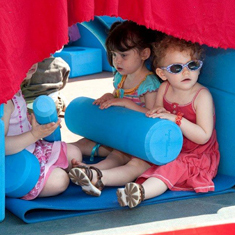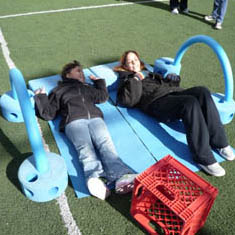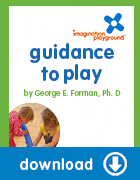Above: A girl makes a lounge chair using two Arch Chutes and some Primary Blocks.
The foam is actually quite comfortable and the scale is perfect for her height. She added parts until it felt just right when she lay back.

These three-year-old girls use the cylinders as a sort of lap rail, similar to the bar in a car seat or amusement ride, as if the foam makes them feel secure and nestled in together.

Using some mats, Primary Blocksfor pillows, and noodles anchored in the Little Cheeses, two girls have a “sleep over” in a life-size double bed.
What It Means
The large scale of the Imagination Playground parts affords an entirely new category of play—building body-sized furniture and equipment. The cushion of the foam often suggests objects for rest (beds, chairs, lounges). The fun comes when you try the structure on for size. The children work to adjust the proportions of their structures to fit the proportions of their body. This work increases the body awareness that is important in many activities. And while building the structures may not require measurement, it certainly involves judgments of equivalence, e.g. is the bed long enough for my height, does the curve of the lounge hit the curve of my bottom, if my arms hang uncomfortably I should I add arm rests.
2-4 Year Olds
Two and three-year-old children love the large scale of these parts. The Imagination Playground Blocks are light, firm, yet cushioned. Younger children learn to sit, lay, and drape their body on them. They may not make a composite structure using several parts, but nonetheless will treat the blocks as something to hold, cradle, or support the body.
4-7 Year Olds
The older children begin with simple structures, like two blocks at right angles to make a chair. But once they actually rest on the structure they discover how it could be improved. The backrest needs more support; the table needs to sit six; the seesaw needs handles. These accessories come both from a pretend theme and from physical events, such as the back rest falling or the seesaw feeling scary.
7-10 Year Olds
Older children may compare their structures, almost competing for which structure is the best. They will carefully consider what makes a structure better, such as the furniture is more comfortable, holds more people, or is more recognizable as a chair versus a sofa versus a bed.
This material is adapted from the publication “Imagination Playground’s Guidance to Play” by George E. Forman, PhD, Emeritus Professor, University of Massachusetts (Amherst) and President of Videatives, Inc.
Dr. Forman has over 33 years of experience in university teaching, cognitive research, multimedia design and educational consulting in the area of early childhood learning and development.
“Guidance to Play” covers 20 topics that help illustrate the significance in what children are doing as they play as well as concrete actions Play Associates can take to facilitate positive behaviors.



